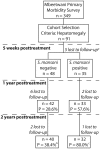Posttreatment changes in cytokines induced by Schistosoma mansoni egg and worm antigens: dissociation of immunity- and morbidity-associated type 2 responses
- PMID: 24357629
- PMCID: PMC4017363
- DOI: 10.1093/infdis/jit826
Posttreatment changes in cytokines induced by Schistosoma mansoni egg and worm antigens: dissociation of immunity- and morbidity-associated type 2 responses
Abstract
Background: Human type 2 cytokine responsiveness to schistosome antigens increases after treatment; due either to removal of the immunosuppressive effects of active infection or immunological boosting by antigens released from dying parasites. We determined the responsiveness to Schistosoma mansoni over a 2-year period, when reinfection was restricted by interrupting transmission.
Methods: The proinflammatory and type 2 responses of Kenyan schoolchildren were measured before, and 1 year and 2 years posttreatment in whole blood cultures stimulated with soluble egg antigen (SEA) or soluble worm antigen (SWA). The site of S. mansoni transmission was molluscicided throughout.
Results: Pretreatment proinflammatory responses to SEA were high but reduced 1 and 2 years posttreatment, whereas type 2 responses were low pretreatment and increased 1 and 2 years posttreatment. Type 2 responses to SWA were high pretreatment and increased at 1 year, with no further increases at 2 years posttreatment. Children infected at follow-up had lower SEA, but not SWA, posttreatment type 2 responsiveness. Increases at 1 year in type 2 SWA, but not SEA, responsiveness correlated with pretreatment egg counts.
Conclusions: Removal of immunosuppressive effects of active infection increases SEA type 2 responsiveness; long-term SWA type 2 responsiveness is due to treatment-induced immunological boosting. Dissociation of type 2 responses potentially protects against severe egg-associated immunopathology during infection, while allowing worm-antigen derived immunity to develop.
Keywords: Schistosoma mansoni; cytokine; human; immunity; immunopathology; praziquantel.
Figures





Similar articles
-
Increased human IgE induced by killing Schistosoma mansoni in vivo is associated with pretreatment Th2 cytokine responsiveness to worm antigens.J Immunol. 2006 Oct 15;177(8):5490-8. doi: 10.4049/jimmunol.177.8.5490. J Immunol. 2006. PMID: 17015735
-
Effects of treatment on IgE responses against parasite allergen-like proteins and immunity to reinfection in childhood schistosome and hookworm coinfections.Infect Immun. 2013 Jan;81(1):23-32. doi: 10.1128/IAI.00748-12. Epub 2012 Oct 15. Infect Immun. 2013. PMID: 23071136 Free PMC article.
-
Effect of praziquantel treatment of Schistosoma mansoni during pregnancy on immune responses to schistosome antigens among the offspring: results of a randomised, placebo-controlled trial.BMC Infect Dis. 2011 Sep 2;11:234. doi: 10.1186/1471-2334-11-234. BMC Infect Dis. 2011. PMID: 21888656 Free PMC article. Clinical Trial.
-
T helper cell populations, cytokine dynamics, and pathology of the schistosome egg granuloma.Microbes Infect. 1999 Jun;1(7):511-6. doi: 10.1016/s1286-4579(99)80090-2. Microbes Infect. 1999. PMID: 10603567 Review. No abstract available.
-
Schistosoma mansoni egg glycoproteins and C-type lectins of host immune cells: molecular partners that shape immune responses.Exp Parasitol. 2012 Sep;132(1):14-21. doi: 10.1016/j.exppara.2011.05.005. Epub 2011 May 15. Exp Parasitol. 2012. PMID: 21616068 Review.
Cited by
-
A Praziquantel Treatment Study of Immune and Transcriptome Profiles in Schistosoma haematobium-Infected Gabonese Schoolchildren.J Infect Dis. 2020 Nov 13;222(12):2103-2113. doi: 10.1093/infdis/jiz641. J Infect Dis. 2020. PMID: 31844885 Free PMC article.
-
Functional Studies of T Regulatory Lymphocytes in Human Schistosomiasis in Western Kenya.Am J Trop Med Hyg. 2018 Jun;98(6):1770-1781. doi: 10.4269/ajtmh.17-0966. Epub 2018 Apr 19. Am J Trop Med Hyg. 2018. PMID: 29692308 Free PMC article.
-
Induction of protective immune responses against schistosomiasis using functionally active cysteine peptidases.Front Genet. 2014 May 8;5:119. doi: 10.3389/fgene.2014.00119. eCollection 2014. Front Genet. 2014. PMID: 24847355 Free PMC article. Review.
-
Stage specific immune responses to schistosomes may explain conflicting results in malaria-schistosome coinfection studies.Infect Dis Model. 2025 May 20;10(4):1003-1018. doi: 10.1016/j.idm.2025.05.008. eCollection 2025 Dec. Infect Dis Model. 2025. PMID: 40520249 Free PMC article.
-
Schistosoma mansoni PCR+ -infected individuals in the Sudan present elevated systemic levels of chemokines when compared to uninfected and egg+ cohorts.Clin Exp Immunol. 2019 Jun;196(3):364-373. doi: 10.1111/cei.13270. Epub 2019 Mar 19. Clin Exp Immunol. 2019. PMID: 30724349 Free PMC article.
References
-
- King CH, Dickman K, Tisch DJ. Reassessment of the cost of chronic helmintic infection: a meta-analysis of disability-related outcomes in endemic schistosomiasis. Lancet. 2005;365:1561–9. - PubMed
-
- Pearce EJ, MacDonald AS. The immunobiology of schistosomiasis. Nat Rev Immunol. 2002;2:499–511. - PubMed
-
- Colley DG, Barsoum IS, Dahawi HS, Gamil F, Habib M, el Alamy MA. Immune responses and immunoregulation in relation to human schistosomiasis in Egypt. III. Immunity and longitudinal studies of in vitro responsiveness after treatment. Trans R Soc Trop Med Hyg. 1986;80:952–7. - PubMed
-
- Grogan JL, Kremsner PG, Deelder AM, Yazdanbakhsh M. Antigen-specific proliferation and interferon-gamma and interleukin-5 production are down-regulated during Schistosoma haematobium infection. J Infect Dis. 1998;177:1433–7. - PubMed
-
- Coutinho HM, Acosta LP, Wu HW, et al. Th2 cytokines are associated with persistent hepatic fibrosis in human Schistosoma japonicum infection. J Infect Dis. 2007;195:288–95. - PubMed
Publication types
MeSH terms
Substances
Grants and funding
LinkOut - more resources
Full Text Sources
Other Literature Sources

